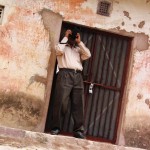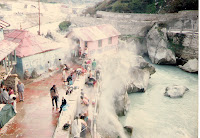Travel India Badrinath
The Most revered Temple of Lord Vishnu
Visiting Char Dham or the ‘four holy pilgrimages’ – Kedarnath, Badrinath, Gangotri and Yamunotri is every devout Hindu’s dream.
Badrinath also known as ‘Vishal Badri’ is situated on the banks of Alaknanda river – 3,133 metres above sea-level.
This temple is the largest and most popular of the five Badri or Vishnu temples in the Himalayas.

The first time I visited Badrinath was during the initial phases of my training as a civil servant.
Class I officers are selected on the basis of a written examination followed by an interview.
The selected officers comprise an odd assortment – from different regions, with diverse educational backgrounds, coming from different strata of society, representing different cultures, etc.
They are given an orientation training designed to enable them to mix with each other and adjust into the elite bureaucratic set up.
It seems rather strange that the training never did me any good.
Till my last days in service, I could never feel myself any different from the ordinary man.
I was and remained a commoner.
My office was open to everyone and sundry.
I never left my office without meeting the last visitor.
As a part of their training, new entrants to the civil services are sent to different parts of the country.
To see things – first hand!
We were sent to Badrinath and Kedarnath.
The program included a visit to the Jawans (Indian army) in the Mana pass.
From Joshimath, military vehicles and escorts took us into the heights of the Mana village and then onwards to the military camp.
The commander there had arranged a mock battle for us.
Two groups of soldiers fought against each other as they would in real war.
Machine guns rattled.
Shells burst and dense smoke billowed.
There were mock attacks.
The soldiers shrieked and shouted and even fell down stone dead as if they had been hit by a bullet.
The soldiers did their best to show off their acting talents.
And they succeeded.
The battle looked very realistic.
I started taking photographs of the mock battle.
A soldier came up to me, reminded me that we were in a prohibited forward area and asked me to stop.
The Commander (a lieutenant colonel) who was watching from a distance immediately stepped in, asked what the problem was, and gave the green signal. “Go ahead. Sir”, he said.
We tasted the normal lunch which our jawans usually have in the high altitude border areas.
I have visited Badrinath twice after that.
Mythology
Badrinath is mentioned in the Hindu ancient texts.
There was an ancient temple here during the ancient times.
Although the statue is very old, the present temple was built recently.
The statue of Lord Vishnu in Badrinath temple is made of Shaligram stone.
It is in the padmasana or sitting pose.
One legend explains why Vishnu’s statue is in the padmasana pose, rather than in the usual reclining pose.
A sage saw Lakshmi (Vishnu’s wife) massaging the feet of Vishnu.
He rebuked Vishnu.Vishnu came down to Badrinath to perform austerity and meditated for a long time in padmasana pose.
The area around Badrinath attracts yogis who come here for meditation and seclusion.
Another legend says that Shiva and Parvati were residing in Badrinath.
Vishnu came disguised as a small child, crying loudly and disturbed them.
Parvati asked the child why he was crying.
He replied that he wanted Badrinath for meditation.
Shiva and Parvati recognised Lord Narayan in disguise.
They left Badrinath and moved over to Kedarnath.
Adi Shankarachary visited Badrintah in the 8th century.
He retrieved the statue of Badrinarayan from the Alaknanda River where it had been thrown away centuries ago and installed it in a cave near the Tapt Kund hot springs.
The King of Garhwal established the present temple in the sixteenth century.
The temple was badly damaged by the earthquake of 1803.
It was then rebuilt by the Maharaja of Jaipur.
Some authors claim that the temple was built on a former Buddhist temple site.
Badrinath temple is flanked by two mountain ranges known as Nar and Narayan.
The majestic Neelkanth peak provides a befitting backdrop.
This area was once carpeted with wild berries which gave it the name ‘Badri Van’, meaning ‘forest of berries’.
The statue of Lord Vishnu is made of Shaligram and depicts him sitting under a badri tree under a gold canopy.
There are fifteen more statues in the temple including statues of Nara & Narayana, Narasimha (the fourth incarnation of Vishnu), Lakshmi, Narada, Ganesha, Uddhava, Kubera, Garuda (the vehicle of Lord Narayan) and Navadurga.
Facing the temple at the bank of Alaknanda river is a hot water spring known as ‘Tapt Kund’. It is supposed to have medicinal properties and curative powers.A bath in this spring is very refreshing. There is a separate tank for women.
Time to Visit
Badrinath is too cold and inaccessible during the winter months.
The temple is closed in November and the statue is moved to nearby Jyotirmath .
The best time to visit Badrinath is between May and October.
The nearest station is Rishikesh (293 kms).
Road
Badrinath is connected by road to Rishikesh (293 km), Haridwar (313 km), Kotdwara (325 km), Joshimath (42 km) & Valley of flowers (38 km), Kedarnath (242 km) and Delhi(518 km).
Places of interest
· Mana Village (3 kms) – the last Indian village near the Indo-Tibetan border. Even today, the traditional people here maintain their own way of life.
· Bheem Bridge – this is a natural bridge over the river Saraswathi, near Mana Village, made of a huge boulder.
· Vasudhara Falls – this is a high waterfall 5 kms after Bheem Bridge.
· Satopanth Lake – this beautiful lake full of lotus flowers is 18 km from Mana Village.
· Pandukesar (20 kms) – this is a memorial for the Pandavas. There are two ancient temples with intricate carvings.
· Govind Ghat – 2 kms before Pandukesar, this is the gateway to the Hem Kund Lake and the fabulous Valley of the Flowers. The Hem Kund is 20 kms by foot from here. The Valley of the Flowers is a 17 kms walk.
· Hanuman Chatti – 13 kms before Badrinath – this is a temple. Nearby is a nursery of rare birch trees.
· Kheerau Valley – when you cross the bridge on the Alaknanda River on the way from Hanuman Chatti to Benakuli, you see this extremely beautiful valley. 4 kms from here is the Kheerau village.
· Joshimath (42 kms) – Adi Shankaracharya visited this place in the 18th century and founded the Mutt called Jyotir math or Joshimath.
The statue is considered to be one of eight swayam vyakta keshtras, or self-manifested statue of Vishnu.
A peculiar feature of this temple is that in accordance with the practice started by Adi Shankaracharya, the Rawal, or head priest of this temple, is a Nambudiri Brahmin from Kerala (south India).
Visit the place.
The journey is most enjoyable.
You will forget the hustles and bustles of city life and get immersed in a world of peace and tranquility.





I want to say – thank you for this!
Incredible site!
viagra
If you have to do it, you might as well do it right
Great site. Good info
This website is awesome. I constantly come across something new & different right here and my seotons. Thank you for that data.